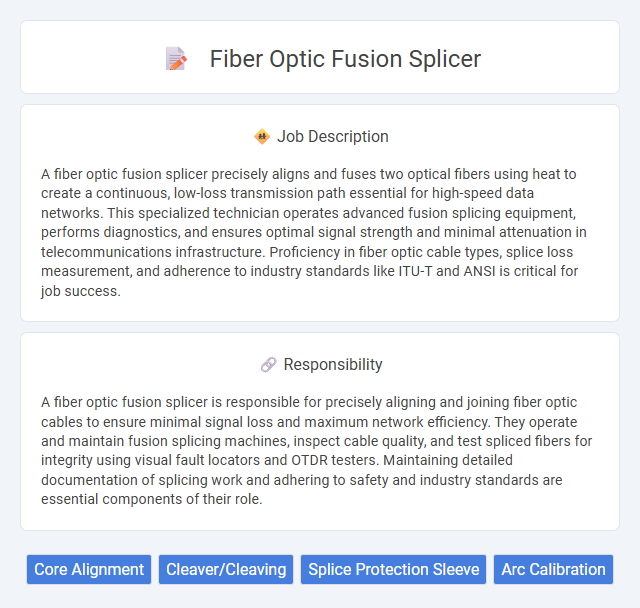
A fiber optic fusion splicer precisely aligns and fuses two optical fibers using heat to create a continuous, low-loss transmission path essential for high-speed data networks. This specialized technician operates advanced fusion splicing equipment, performs diagnostics, and ensures optimal signal strength and minimal attenuation in telecommunications infrastructure. Proficiency in fiber optic cable types, splice loss measurement, and adherence to industry standards like ITU-T and ANSI is critical for job success.
Individuals with strong hand-eye coordination and attention to detail are likely well-suited for a fiber optic fusion splicer job, as the work requires precise alignment and splicing of delicate fiber optic cables. Those who are comfortable working in varying environments, including confined spaces or outdoors, may adapt more easily to the physical conditions of the role. People with a patient and methodical approach may also have a higher probability of success in this field, given the need for accuracy and troubleshooting during installations.
Qualification
Fiber optic fusion splicer technicians require specialized qualifications including a high school diploma or equivalent, with preferred certifications such as the Certified Fiber Optic Technician (CFOT) or equivalent industry credentials. Proficiency in handling fusion splicing equipment, understanding fiber optic cable types, and knowledge of optical loss testing are critical skills. Strong attention to detail, manual dexterity, and the ability to interpret technical documentation ensure high-quality splicing and minimal signal loss.
Responsibility
A fiber optic fusion splicer is responsible for precisely aligning and joining fiber optic cables to ensure minimal signal loss and maximum network efficiency. They operate and maintain fusion splicing machines, inspect cable quality, and test spliced fibers for integrity using visual fault locators and OTDR testers. Maintaining detailed documentation of splicing work and adhering to safety and industry standards are essential components of their role.
Benefit
Working as a fiber optic fusion splicer likely offers the benefit of high demand in telecommunications and networking industries, enhancing job security and career growth opportunities. The role probably provides competitive salaries and benefits due to the specialized skills required for precision fiber splicing. Exposure to advanced technology and hands-on technical work could contribute to professional development and job satisfaction.
Challenge
Fiber optic fusion splicer jobs likely involve overcoming significant challenges related to precision and environmental conditions, as splicing requires exact alignment of fibers to minimize signal loss. The probability of encountering difficulties such as dust, moisture, or equipment malfunctions can impact the quality and efficiency of splicing work. Mastery in handling these challenges may directly influence network performance and reliability.
Career Advancement
Fiber optic fusion splicer technicians play a critical role in telecommunications by joining optical fibers with precision to ensure efficient data transmission. Career advancement opportunities include progressing to positions such as network engineer, fiber optic technician supervisor, or project manager, often requiring certifications like the Certified Fiber Optic Technician (CFOT). Gaining experience with advanced fusion splicing equipment and mastering fiber optic network troubleshooting significantly enhances prospects for higher-level and specialized roles.
Key Terms
Core Alignment
Fiber optic fusion splicer technicians specialize in aligning the fiber cores with precision to achieve minimal signal loss and optimal network performance. Core alignment technology utilizes advanced imaging and motorized adjustments to fuse fibers accurately, enhancing connectivity in telecommunication and data transmission systems. Mastery of core alignment ensures high splice quality, reducing attenuation and enabling reliable optical fiber network installations and repairs.
Cleaver/Cleaving
Fiber optic fusion splicer technicians rely heavily on precision cleavers to ensure clean, perpendicular fiber ends critical for low-loss splicing. Proper cleaving minimizes defects and enables the splicer to align fibers accurately, resulting in stronger, more reliable optical connections. Mastery of cleaving techniques directly influences splice quality, signal integrity, and overall network performance.
Splice Protection Sleeve
Fiber optic fusion splicer technicians specialize in joining optical fibers using precise fusion splicing equipment, ensuring minimal signal loss and high-strength connections. The splice protection sleeve plays a critical role by encasing the fusion splice, providing mechanical protection, and preventing environmental damage. These sleeves typically consist of heat-shrink tubing reinforced with a steel rod core, ensuring durability and long-term reliability in fiber optic networks.
Arc Calibration
Arc calibration in fiber optic fusion splicer jobs ensures precise alignment and optimal splicing quality by adjusting the electric arc's intensity and duration. Proper arc calibration reduces splice losses and minimizes fiber damage, directly impacting network performance and reliability. Technicians rely on accurate calibration procedures and equipment settings to maintain consistent fusion results, vital for high-speed data transmission infrastructure.
 kuljobs.com
kuljobs.com